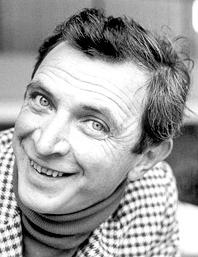
The Royal Ballet is a British internationally renowned classical ballet company, based at the Royal Opera House in Covent Garden, London, England. The largest of the five major ballet companies in Great Britain, the Royal Ballet was founded in 1931 by Dame Ninette de Valois. It became the resident ballet company of the Royal Opera House in 1946, and has purpose-built facilities within these premises. It was granted a royal charter in 1956, becoming recognised as Britain's flagship ballet company.

John Cyril Cranko was a South African ballet dancer and choreographer with the Royal Ballet and the Stuttgart Ballet.

Sir Kenneth MacMillan was a British ballet dancer and choreographer who was artistic director of the Royal Ballet in London between 1970 and 1977, and its principal choreographer from 1977 until his death. Earlier he had served as director of ballet for the Deutsche Oper in Berlin. He was also associate director of the American Ballet Theatre from 1984 to 1989, and artistic associate of the Houston Ballet from 1989 to 1992.
L'histoire de Manon, generally referred to as Manon, is a ballet choreographed by Kenneth MacMillan to music by Jules Massenet and based on the 1731 novel Manon Lescaut by Abbé Prévost. The ballet was first performed by The Royal Ballet in London in 1974 with Antoinette Sibley and Anthony Dowell in the leading roles. It continues to be performed and recognised internationally.
Sir Peter Wright CBE is a British ballet teacher, choreographer, director and former professional dancer. He worked as a choreographer and as the artistic director of Birmingham Royal Ballet, a classical ballet company based in Birmingham, England. On retiring from the company in 1995, he was bestowed the honorary title of director laureate of the company.
David Blair was a British ballet dancer and a star of England's Royal Ballet during the 1950s and 1960s.
Choreographer Sir Kenneth MacMillan's Royal Ballet production of Sergei Prokofiev's Romeo and Juliet premiered at the Royal Opera House, Covent Garden on 9 February 1965.
The Lady and the Fool is a ballet, created by choreographer John Cranko with lesser-known operatic music by Giuseppe Verdi arranged by Sir Charles Mackerras. The story concerns the love of a poor clown for a society beauty, who finally rejects her wealthy suitors and chooses a life with the clown.

Ashley Macdonald Lawrence, was a New Zealand conductor mainly active in the UK and Germany, and particularly associated with ballet.

Georgina Parkinson was an English ballet dancer and ballet mistress. She joined The Royal Ballet in 1957 and was promoted to principal dancer in 1962. Best known for dancing 20th-century works, she was a frequent collaborator of choreographer Kenneth MacMillan, and had also created roles for Frederick Ashton. In 1978, she accepted the invitation to become a ballet mistress at the American Ballet Theatre for a year, before assuming the position permanently in 1980. She also performed character roles with the American Ballet Theatre.

Susan Jaffe is an American ballet dancer and arts administrator. She is currently the artistic director of the American Ballet Theatre, where she had danced for 22 years and held the rank of principal dancer. She previously served as the dean of the School of Dance at the University of North Carolina School of the Arts and the artistic director of Pittsburgh Ballet Theatre.
Elite Syncopations is a one-act ballet created in 1974 by Kenneth MacMillan for The Royal Ballet.

Richard Cragun was an American ballet dancer, teacher and ballet director who performed with the Stuttgart Ballet in Germany from 1965 to 1996.

Marcia Haydée Salaverry Pereira da Silva is a Brazilian ballet dancer, choreographer and ballet director. She was prima ballerina of the Stuttgart Ballet under John Cranko and succeeded him as the company's director, serving from 1976 to 1995. She has been director of the Santiago Ballet since 1992.
Ivan Cavallari is a dancer and choreographer and artistic director. He is currently at the head of the artistic direction of Les Grands Ballets Canadiens de Montréal.
Desmond Doyle was a South African ballet dancer who performed in England in the 1950s and 1960s before becoming ballet master of The Royal Ballet.

The Song of the Earth is a ballet based on Das Lied von der Erde, a symphonic work written by the Austrian composer Gustav Mahler in 1908–1909. It is scored for two voices and orchestra, and has been used for ballets by several well-known choreographers, including Antony Tudor (1908–1987), Kenneth MacMillan (1929–1992), Heinz Spoerli, and John Neumeier.
The Rite of Spring is a one-act ballet created by Kenneth MacMillan in 1962 for the Royal Ballet, set to Igor Stravinsky's The Rite of Spring (1913). The conductor was Colin Davis, and the designs were by Sidney Nolan.

Egon Madsen is a Danish ballet dancer, teacher, ballet master and company director. In 1961, he joined the Stuttgart Ballet, where John Cranko had become the director. Madsen was hired as a soloist but was soon promoted to principal dancer, and created numerous roles for Cranko. He retired from Stuttgart in 1981.
Initials R.B.M.E. is a ballet choreographed by John Cranko to Brahms' Piano Concerto No. 2. The ballet is plotless, and features four movements, each with a lead dancer. The ballet was created for the Stuttgart Ballet, and the title was named after the dancers that originated the four lead roles, Richard Cragun, Birgit Keil, Marcia Haydée and Egon Madsen. Initials R.B.M.E. premiered on 18 January 1972, at the Staatsoper Stuttgart. It was one of Cranko's most successful ballets, and one of his final works before his sudden death in 1973.